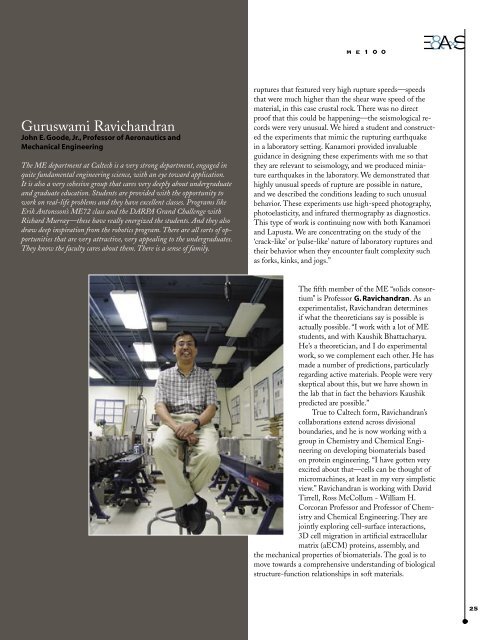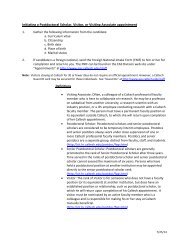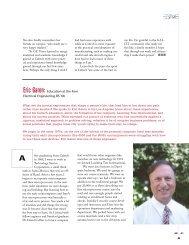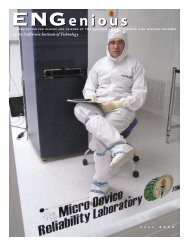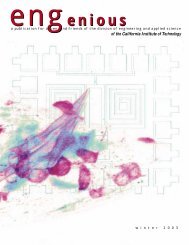Issue No.6 PDF (3 MB) - Division of Engineering and Applied Science
Issue No.6 PDF (3 MB) - Division of Engineering and Applied Science
Issue No.6 PDF (3 MB) - Division of Engineering and Applied Science
You also want an ePaper? Increase the reach of your titles
YUMPU automatically turns print PDFs into web optimized ePapers that Google loves.
m e 1 0 0<br />
Guruswami Ravich<strong>and</strong>ran<br />
John E. Goode, Jr., Pr<strong>of</strong>essor <strong>of</strong> Aeronautics <strong>and</strong><br />
Mechanical <strong>Engineering</strong><br />
The ME department at Caltech is a very strong department, engaged in<br />
quite fundamental engineering science, with an eye toward application.<br />
It is also a very cohesive group that cares very deeply about undergraduate<br />
<strong>and</strong> graduate education. Students are provided with the opportunity to<br />
work on real-life problems <strong>and</strong> they have excellent classes. Programs like<br />
Erik Antonsson’s ME72 class <strong>and</strong> the DARPA Gr<strong>and</strong> Challenge with<br />
Richard Murray—these have really energized the students. And they also<br />
draw deep inspiration from the robotics program. There are all sorts <strong>of</strong> opportunities<br />
that are very attractive, very appealing to the undergraduates.<br />
They know the faculty cares about them. There is a sense <strong>of</strong> family.<br />
ruptures that featured very high rupture speeds—speeds<br />
that were much higher than the shear wave speed <strong>of</strong> the<br />
material, in this case crustal rock. There was no direct<br />
pro<strong>of</strong> that this could be happening—the seismological records<br />
were very unusual. We hired a student <strong>and</strong> constructed<br />
the experiments that mimic the rupturing earthquake<br />
in a laboratory setting. Kanamori provided invaluable<br />
guidance in designing these experiments with me so that<br />
they are relevant to seismology, <strong>and</strong> we produced miniature<br />
earthquakes in the laboratory. We demonstrated that<br />
highly unusual speeds <strong>of</strong> rupture are possible in nature,<br />
<strong>and</strong> we described the conditions leading to such unusual<br />
behavior. These experiments use high-speed photography,<br />
photoelasticity, <strong>and</strong> infrared thermography as diagnostics.<br />
This type <strong>of</strong> work is continuing now with both Kanamori<br />
<strong>and</strong> Lapusta. We are concentrating on the study <strong>of</strong> the<br />
‘crack-like’ or ‘pulse-like’ nature <strong>of</strong> laboratory ruptures <strong>and</strong><br />
their behavior when they encounter fault complexity such<br />
as forks, kinks, <strong>and</strong> jogs.”<br />
The fifth member <strong>of</strong> the ME “solids consortium”<br />
is Pr<strong>of</strong>essor G. Ravich<strong>and</strong>ran. As an<br />
experimentalist, Ravich<strong>and</strong>ran determines<br />
if what the theoreticians say is possible is<br />
actually possible. “I work with a lot <strong>of</strong> ME<br />
students, <strong>and</strong> with Kaushik Bhattacharya.<br />
He’s a theoretician, <strong>and</strong> I do experimental<br />
work, so we complement each other. He has<br />
made a number <strong>of</strong> predictions, particularly<br />
regarding active materials. People were very<br />
skeptical about this, but we have shown in<br />
the lab that in fact the behaviors Kaushik<br />
predicted are possible.”<br />
True to Caltech form, Ravich<strong>and</strong>ran’s<br />
collaborations extend across divisional<br />
boundaries, <strong>and</strong> he is now working with a<br />
group in Chemistry <strong>and</strong> Chemical <strong>Engineering</strong><br />
on developing biomaterials based<br />
on protein engineering. “I have gotten very<br />
excited about that—cells can be thought <strong>of</strong><br />
micromachines, at least in my very simplistic<br />
view.” Ravich<strong>and</strong>ran is working with David<br />
Tirrell, Ross McCollum - William H.<br />
Corcoran Pr<strong>of</strong>essor <strong>and</strong> Pr<strong>of</strong>essor <strong>of</strong> Chemistry<br />
<strong>and</strong> Chemical <strong>Engineering</strong>. They are<br />
jointly exploring cell-surface interactions,<br />
3D cell migration in artificial extracellular<br />
matrix (aECM) proteins, assembly, <strong>and</strong><br />
the mechanical properties <strong>of</strong> biomaterials. The goal is to<br />
move towards a comprehensive underst<strong>and</strong>ing <strong>of</strong> biological<br />
structure-function relationships in s<strong>of</strong>t materials.<br />
25


